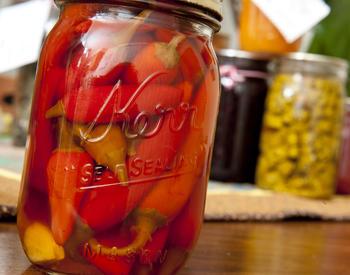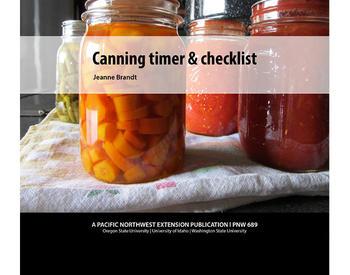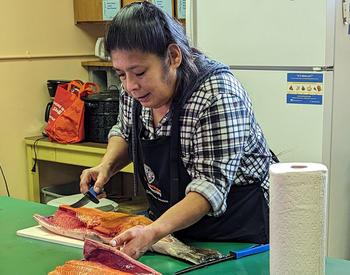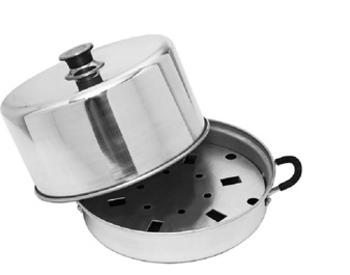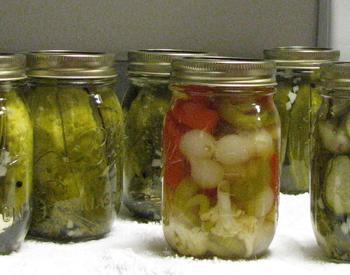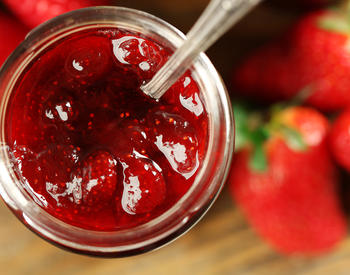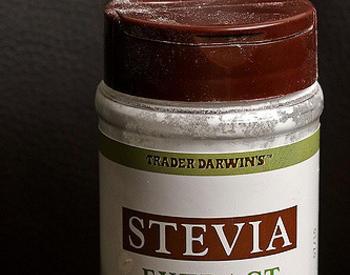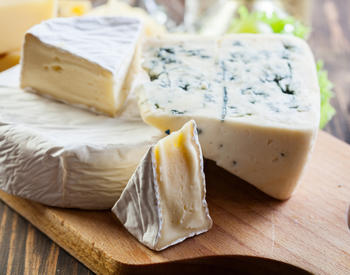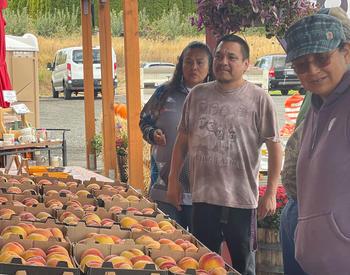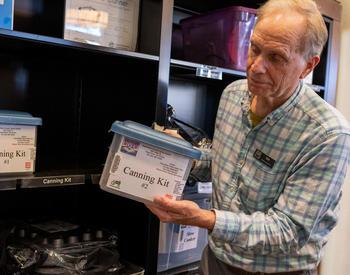Download this publication as a PDF
When making jams, jellies and preserves from fruits that contain natural pectin, it's not necessary to add additional pectin. These products are cooked to the desired consistency.
Basic steps for making fruit spreads without added pectin
- Assemble all equipment and ingredients according to the recipe.
- Clean and sterilize canning jars and prepare lids according to manufacturer's instruction.
- Select firm, slightly underripe fruit (the best source of pectin) and prepare according to recipe. Remove pits and stems. Mash fruit with a potato masher (not a food processor) and measure fruit accurately.
- Cook spread according to the directions given in the recipe. Cook jams and preserves until thickened. Cook jelly to a temperature 8 degrees F above the boiling point of water (220 degrees F at sea level) or until two drops form together and "sheet" off a cold metal spoon.
- Remove from heat and skim foam. Pour jelly immediately into hot jars. For jams and preserves, stir gently for 5 minutes to cool, which will prevent the fruit from floating in the jar. Pour hot jam into jars, leaving ¼-inch headspace, wipe jar rims, adjust lids and process in a boiling water canner for 5 minutes.
Jam recipes
Berry jams
(Blackberry, blueberry, boysenberry, dewberry, gooseberry, loganberry, raspberry and youngberry)
Yield: 7 or 8 half-pint jars
- 9 cups crushed berries
- 6 cups sugar
Directions:
- Sterilize canning jars.
- Combine berries and sugar. Bring slowly to a boil, stirring occasionally until sugar dissolves.
- Cook rapidly to, or almost to, gelling point, depending upon whether a firm or soft jam is desired.
- As mixture thickens, stir frequently to prevent sticking.
- Pour hot jam into hot jars, leaving ¼-inch headspace. Wipe rims and adjust lids.
- Process 5 minutes in a boiling water canner.
- After processing, take canner off heat, remove lid. Wait 5 minutes before removing jars.
Note: If seedless jam is preferred, crushed berries may be heated until soft and pressed through a sieve or food mill; then add sugar and proceed as above.
Grape jam
Yield: about 6 half-pint jars
- 2 quarts stemmed Concord grapes
- 6 cups sugar
Directions:
- Sterilize canning jars.
- Separate pulp from skins of grapes. If desired, chop skins in a food blender or chopper.
- Cook skins gently 15–20 minutes, adding only enough water to prevent sticking (about 1/2 cup).
- Cook pulp without water until soft; press through a sieve or food mill to remove seeds. Combine pulp, skins and sugar. Bring to the gelling point, about 10 minutes.
- As mixture thickens, stir frequently to prevent sticking. Pour into hot jars, leaving ¼-inch headspace. Wipe jar rims and adjust lids. Process 5 minutes in a boiling water canner.
- After processing, take canner off heat. Remove lid. Wait 5 minutes before removing jars.
Peach jam
Yield: about 8 half-pint jars
- 2 quarts crushed, peeled peaches
- 1/2 cup water
- 6 cups sugar
Directions:
- Sterilize canning jars.
- Combine peaches and water; cook gently 10 minutes.
- Add sugar; slowly bring to boiling, stirring occasionally until sugar dissolves.
- Cook rapidly until thick, about 15 minutes; stir frequently to prevent sticking.
- Pour hot jam into hot jars, leaving ¼-inch headspace. Wipe jar rims and adjust lids.
- Process 5 minutes in boiling water canner.
- After processing, take canner off heat. Remove lid. Wait 5 minutes before removing jars.
Variation
For spiced peach jam, tie the following ingredients in cheesecloth and add to the jam during cooking:
- 1 teaspoon whole cloves
- 1/2 teaspoon whole allspice
- 1 stick cinnamon( 3-inch piece)
Strawberry jam
Yield: about 8 half-pint jars
- 2 quarts crushed strawberries
- 6 cups sugar
Directions:
- Sterilize canning jars.
- Combine berries and sugar; bring slowly to boiling, stirring occasionally until sugar dissolves.
- Cook rapidly until thick, about 40 minutes. As mixture thickens, stir frequently to prevent sticking.
- Pour hot jam into hot jars, leaving ¼-inch headspace.
- Wipe jar rims and adjust lids. Process 5 minutes in a boiling water canner.
- After processing, take canner off heat. Remove lid. Wait 5 minutes before removing jars.
Jelly recipes
Apple jelly
Yield: 4 or 5 half-pint jars
- 4 cups apple juice (about 3 pounds apples and 3 cups water)
- 2 tablespoons lemon juice, if desired
- 3 cups sugar
To prepare juice, use method outlined in SP 50-632, Making Berry Syrups at Home.
To make jelly:
- Sterilize canning jars.
- Measure apple juice into a saucepot. Add lemon juice and sugar and stir well.
- Boil over high heat to 8 degrees F above the boiling point of water or until jelly mixture sheets from a spoon.
- Remove from heat; skim off foam quickly.
- Pour jelly immediately into hot canning jars, leaving ¼-inch headspace.
- Wipe jar rims and adjust lids. Process 5 minutes in a boiling water canner. After processing, take canner off heat. Remove lid. Wait 5 minutes before removing jars.
Blackberry jelly
Yield: about 10 half-pint jars
- 4 cups blackberry juice (about 2½ quart boxes berries and 3/4 cups water)
- 3 cups sugar
To prepare juice: Use method outlined in SP 50-632, Making Berry Syrups at Home.
To make jelly:
- Sterilize canning jars.
- Measure juice into a saucepot. Add sugar and stir well. Boil over high heat to 8 degrees F above boiling point of water or until jelly mixture sheets from a spoon.
- Remove from heat; skim off foam quickly.
- Pour jelly immediately into hot canning jars, leaving ¼-inch headspace. Process 5 minutes in a boiling water canner.
- After processing, take canner off heat. Remove lid. Wait 5 minutes before removing jars.
Preserve recipes
Strawberry-rhubarb preserves
Yield: about 10 half-pint jars
- 4 cups sliced rhubarb (½-inch thick)
- 4 cups strawberries
- 7 cups sugar
Directions:
- Wash and cut rhubarb into ½-inch slices.
- Wash and hull 1-quart strawberries. Measure 4 cups of each into a large kettle. Add sugar.
- Slowly bring to a boil, stirring occasionally until sugar dissolves.
- When sugar dissolves, start stirring frequently to prevent sticking. Cook rapidly until thick. Remove from heat. Skim off any foam.
- Pour, boiling, into jars, leaving ¼-inch headspace. Seal. Process 15 minutes in boiling water canner.
- After processing, take canner off heat. Remove lid. Wait 5 minutes before removing jars.
Fig preserves
Yield: about 10 half-pint jars
- 3 quarts figs
- 3 quarts boiling water
- 4 cups sugar
- 1 1/2 quarts water
- 2 lemons, thinly sliced (optional)
Directions:
- Pour boiling water over figs. Let stand 15 minutes. Drain. Rinse figs in cold water.
- Prepare syrup by mixing sugar, 1½ quarts water, and lemon. Boil rapidly 10 minutes.
- Skim syrup, remove and discard lemon slices.
- Drop figs into syrup, a few at a time. Cook rapidly until figs are transparent. Remove figs and place in a shallow pan.
- Boil syrup until thick, pour over figs, and let stand 6 to 8 hours.
- Sterilize canning jars.
- Reheat figs and syrup to boiling.
- Pour hot preserves into hot jars, leaving ¼-inch headspace. Wipe jar rims and adjust lids.
- Process 5 minutes in a boiling water canner.
- After processing, take canner off heat. Remove lid. Wait 5 minutes before removing jars.
Related articles
Source: OSU Master Food Preserver Program
